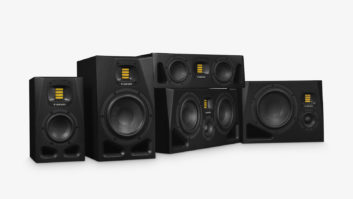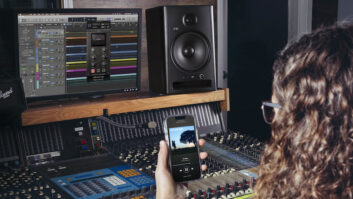Over the past decade, ADAM Audio has cut a wide swath into the studio monitor marketplace. Due to the proprietary Accelerating Ribbon Technology (ART) utilized in its folded ribbon tweeter designs, ADAM Audio is fairly equated with a natural, aurally pleasing and extended high frequency response (at a generally higher-end price point, too).
Now, as low as $250 street per box (the F5), we could assume that the lowest-priced-ever ADAM monitor line—the F Series featuring ART, with an even further “eXtended” frequency response of “up to 50 kHz”—is somehow a fair step down in capability and quality, too. Yet from what I’ve experienced, that assumption would be wrong; while the company does utilize Chinese manufacturing plants to assemble the F Series, its design, components, specifications and performance are spot-on for this aspirational German manufacturer.
Features
Reviewed here, the F7 is ADAM Audio’s larger of its two F Series full-range loudspeakers, featuring a 7-inch fiberglass/paper woofer and ART tweeter, powered by a Class A/B dual channel amplifier (35 W of continuous power transducer). The smaller F5 is available, different only by its woofer’s 5-inch diameter, a slightly smaller cabinet and 25 W/25 W amplifier. An F7 pair provides a maximum acoustic output of 109 dB SPL. Also available is the F Series’ SubF subwoofer featuring an 8-inch woofer and 110 W of Class A/B mono amplification at 107 dB SPL within a compact, 21.8 lb., 14” x 10” x 13.5” cabinet (the FSub was not included in this review package). The F Series cabinetry is made of an attractive, scratch-resistant MDF (medium-density fiberboard) of industry-standard level quality.
The F7 features comprehensive analog input options—combo XLR/TRS and RCA jacks; a present RCA input automatically disables XLR/TRS input. Controls include rotary +/-6dB shelving filter knobs, set at 5 kHz and 300 Hz, respectively; rotary level control, to +6dB (+12dB for SubF); and—recommended for use with a subwoofer—80Hz high-pass filter on/off switch. The front panel provides a two LED logo panel; a green LED lights when power is on; a red LED lights in Standby, or low power mode, with its automatic signal sensing feature.
In Use
In my own private production space, I simply switched the ADAM A7 pair with my personal standard, a pair of KRK VXT8 midfield studio monitors. Despite the differences in both price point, size and power—the VXT8 is higher, larger, and stronger, respectively—I noticed an immediate improvement in imaging and appreciated the ART tweeter’s characteristically smooth performance. When auditioning a series of very familiar material, percussive sound sources—from arpeggiated guitar runs to specific cymbals within the stereo landscape—seemed pinpoint accurate; the F7 made me feel very confident in knowing precisely where things fell within a mix.
For a street price of $399 each (at least $400/pair less than my normal monitors), I was pleasantly surprised by the F7’s performance. Though I didn’t have ADAM’s dedicated F Series subwoofer, the SubF, for the evaluation (also $399 street), I found it interesting that a full three-piece F Series rig (two mains and subwoofer) would clock in at exactly the same price as my VXT8 pair. And, for users in smaller, more common modern audio workspaces, this makes the F Series a much more logical choice, I believe, than the kind of midfield powered monitors I normally depend on.
Summary
There are no gimmicks and few frills to be found in the F Series: just solid performance for the discriminating, yet budget-conscious and/or space-limited audio producer.
Strother Bullins is an active live and recording musician as well as the editor of Pro Audio Review.
Prices: $399 street, each
Contact: ADAM Audio | http://www.adam-audio.com
Second Opinion: ADAM F7
By Rich Tozzoli
The F7 pair is hefty—at least to me—for a compact studio monitoring system; at about 20 lbs. each, I had to readjust my nearfield speaker stands so they didn’t fall. Upon power up, the green light indicated I was good to go, and I then went around back to make some adjustments.
Since the pair came without a SubF subwoofer, I left the high-pass filter set to flat, then set Level to 0. I also checked that the 5 kHz and 300 Hz EQ filters were set to 0 (flat)—something I found a bit hard to do since there’s no marker on it, only an indentation in the all black screw (I would suggest a colored null point to allows users to easily see settings). Also, I was wondering why the AC cables were only 2 prong and not three. Luckily there was no buzz and they were silent even when “live.”
Now, the important thing: the sound. I’ve worked on ADAM monitors before (both A8X and A7X models), so I felt I knew what to expect. Like its cousins, the F7 sounds seriously good. I started by referencing my own and familiar edgy rock mix of full drums, bass and guitars. It was beefy yet smooth, and I had forgotten about how ‘forward’ I’ve generally felt ADAM speakers are; with the F7 pair, the sound is right in your face. Monitoring solo acoustic guitar (Jumbo Guild F50 via Earthworks QTC1 with Grace m103 pre-amplification) was clean, clear and crisp. Male vocals were also notably present (via Miktek C7 with Focusrite ISA pre-amplification); I was able to easily judge how much compression and reverb to add.
Next, I called up some aggressive patches in Heavyocity’s AEON, ranging from pumping pulsing lows to shimmering highs. Again, the F7s were very present and forward though well-balanced. Calling up a nice ambient piano patch in Reason with a ton of reverb, I became completely lost in the sound. In fact, with both instruments, I started composing immediately. That, to me, is the sign of a well done studio monitors: they inspire production.
As I’ve mixed on the same satellite/subwoofer setup for a decade, I’m used to having a subwoofer. Do these need one? No and yes. With the rock mix, I swept a Brainworx bx_Digital EQ plug-in on the kick and bass (solo isolated); I found low end drop-off at approximately 100 Hz. I did the same sweep on the high end with a GML/Sonnox EQ and Manley Massive Passive; all that info was all there, as expected. That said, I would definitely pair the F7s with its SubF if mixing full range. Other than that, these speakers are spot-on. I would comfortably mix with them, without hesitation.
Rich Tozzoli is a Grammy-nominated mixer/producer, a prolific TV composer and the software editor for Pro Audio Review. http://www.richtozzoli.com







